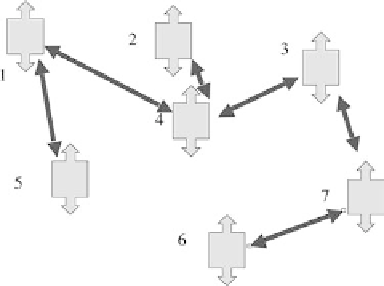Information Technology Reference
In-Depth Information
Figure 7.1.
A set of interacting two-state nodes forms a small web. The two-headed arrows indicate the
interactions among the two-state nodes.
Let us imagine that each node of the given network is a dynamical unit described
by the master equation (
7.9
). To establish a dynamical connection among the nodes of
this network imagine that a given unit is influenced by all the other units to which it
is directly connected. In Figure
7.1
we illustrate this condition, where node 1 interacts
directly with nodes 4 and 5 and indirectly with nodes 2 and 3. As a consequence of
these interactions one possible choice for the coupling coefficients in (
7.9
)istousethe
time-dependent transition probabilities per unit time given by [
15
,
64
]
g
ij
(
t
)
=
g
exp
(
K
[
π
j
(
t
)
−
π
i
(
t
)
]
).
(7.11)
Note that in the Ising model mentioned earlier, a model used extensively in condensed-
matter physics, all the coupling coefficients are constants and we emphasize that this is
not the case being considered here. The weighting factors in the interaction coefficient
(
7.11
) are given by the relative number of sites in the indicated state, that is,
M
r
M
,
π
r
=
(7.12)
where
M
r
is the number of sites of that specific subset that are in the state
r
2
and
M
denotes the total number of nodes connected to the site which is being con-
sidered. For instance
M
=
1
,
2 in the case in which the site we are considering is site
1 of Figure
7.1
. The parameter
K
is the control parameter in the exponential (
7.11
)
generating the coupling factor
=
exp
K
π
j
(
.
C
ij
=
t
)
−
π
i
(
t
)
(7.13)
To illustrate what we mean, let us assume that the site we are considering, namely
site 1 in our example, is in the state
r
1. Assume that both sites linked to it are in the
same state. In this situation the coupling factor is
e
−
2
K
. Thus, site 1 tends to remain in
the state
r
=
1 for a more extended time than it would in the absence of any coupling.
If both linked sites are in the state
r
=
2, the coupling factor is
e
2
K
, and site 1 makes a
=
transition from state
r
=
1 to state
r
=
2 earlier than it would in the absence of coupling.
When site 4 is in the state
r
=
1(
r
=
2) and site 5 is in the state
r
=
2(
r
=
1), site 1


